A 13-month-old boy with a rash
A 13-month-old boy presented to the clinic with the chief complaint of a rash on his face about the right ear.
The onset was the day before when the mother noticed a streak of erythema from the right ear to the cheek. That evening, the patient was noted to be febrile with a temperature of 102.5°F. When the patient awoke the next morning, the area of erythema had spread considerably toward the cheek and behind the ear. This was all preceded by a few days of upper respiratory infection symptoms and decreased oral intake with a couple of episodes of emesis.

Pediatric Infectious Disease, Scott and White's Children's Health Center and Associate Professor of Pediatrics,
Texas A&M University, College of Medicine, Temple, Texas.
e-mail: jhbrien@aol.com
His past medical history was positive for some mild seborrhea of the scalp, including the skin about the ears, occasionally treated with steroid and antifungal creams. He was also born slightly premature at 34½-weeks gestation, requiring a five-day stay in the NICU for poor feeding. Since then, he has had a few minor infections, but otherwise has been in good health. Because of his prematurity, he also received monthly Synagis (MedImmune) for RSV prophylaxis during the RSV season of his first year of life. His review of systems was otherwise unremarkable.
His immunizations are documented up-to-date for age.
His family and social history was highly significant for recent sick exposures, with his 5-year-old brother having been diagnosed with streptococcal pharyngitis in their pediatrician’s office with a confirmatory test, as well as both parents with positive cultures, beginning two weeks prior to the onset of the patient’s current illness.
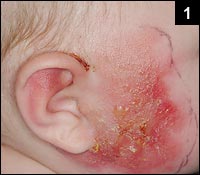

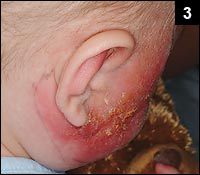
Examination on admission revealed normal vital signs and a normal-appearing, active 13-month-old in no acute distress. He had an obvious area of erythema on the right side of his face as shown in figures 1 – 3. The rash was a bit raised with sharply defined margins and contained some crusting material with a few vesicles of various sizes on a diffuse erythematous base. The rest of his examination was normal.
Lab tests done included a CBC with a white blood cell count of 18,000 with a blood culture pending. A lesion on the rash was also cultured for bacteria and herpes simplex virus (HSV).
What’s your diagnosis?
- Cutaneous HSV
- Buccal cellulitis
- Erysipelas
- Parotitis
Answer
This is a fairly good description of erysipelas (choice C), a very superficial soft tissue infection involving the subcutaneous tissues and lymphatic vessels, and is usually caused by group A streptococcus (Streptococcus pyogenes), although other streptococci and Staphylococcus aureus may also result in the same condition.
The port-of-entry was likely the damaged skin from the seborrhea about the scalp and ears.
Because of the superficial nature of the cellulitis, the characteristic rash has a raised edge, giving it a sharp line of demarcation. The skin will be bright red with an orange peel appearance. It is also not unusual to see vesicles and even bullae overlying the rash (Figures 4 and 5).
The history of patient’s with this condition often includes a recent respiratory tract infection and exposure to, or infection with group A strep. The face about the ear is a common location for classic erysipelas, but it can occur anywhere on the body where there is a port-of-entry and the colonization of the organism. Although bacteremia occasionally complicates erysipelas, our patient’s blood culture was negative. However, the lesion culture was positive for group A strep. My recommendation for empiric therapy pending culture results would be intravenous penicillin plus clindamycin for the possibility of group A strep or methicillin-resistant S. aureus (MRSA). After clinical improvement, treatment can be changed to an oral antibiotic. Our patient was notably improved within 48 hours as shown in figures 4 and 6 below, and sent home taking oral Keflex (because it tastes good).
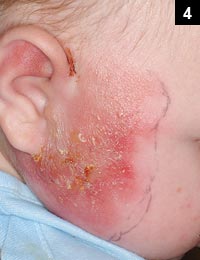
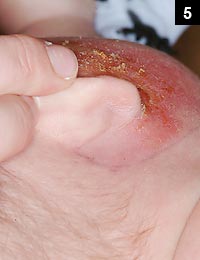

Cutaneous herpes simplex virus (HSV) infection would certainly have vesicles, and may have a similar appearing skin, as shown in figure 7. However, one would not as likely see the satellite vesicles with erysipelas, as those seen with HSV. Our patient’s HSV culture was negative.
Buccal cellulitis was one of the classic infections of Haemophilus influenzae type b (Hib), in the good old days.
The skin would have a smooth, bright red appearance with swelling as shown in figures 8 and 9. It typically occurred as a complication of bacteremia with Hib, and had a high association with concurrent meningitis. I speak of this in the past-tense since invasive Hib disease has become a rarity. However, it’s not gone, so stay alert.
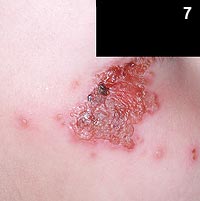
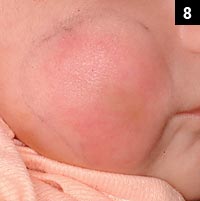
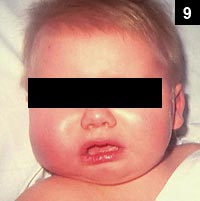
Lastly, the parotid gland is in the same location, but parotitis results in swelling with minimal, if any overlying erythema, as shown in figures 10 and 11, a patient with viral parotitis. The etiology is usually viral, but bacterial parotitis can also occur. Usually a good history and physical is all that’s needed to differentiate, but culture of pus from the Stensen duct of the involved parotid gland will usually yield the cause if bacterial, which is usually S. aureus. Since the widespread use of mumps vaccine, viral parotitis has become very uncommon.
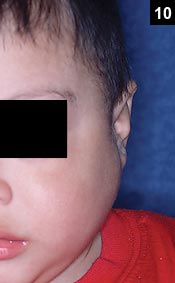
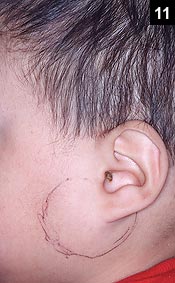
Columnist comments
All you ever wanted to know about the conditions discussed above, and much more, can be found in the “long-” awaited third edition of Sarah Long’s, MD, Principles and Practice of Pediatric Infectious Diseases textbook, which is now out. She also got a little help from Larry Pickering, MD, at the CDC and Charles Prober, MD, at Stanford.
Together, they came up with a completely new look in a 1,618-page text that is packed with information in an easy-to-use format.
It comes complete with color pictures, tables or figures on almost every page to augment the text, which is surprisingly complete for a single-volume book. Also, for a book this size, it seems to be about half the weight of a similar text with color pictures, making it very easy to handle. I have a pediatric dermatology book with similar color pictures in a book that is about 300 FEWER pages that is twice the weight of this book. I don’t know what kind of paper Sarah’s publisher is using, but I suspect it was developed by NASA. Lastly, it comes with a CD version in the front cover, which weighs even less. It is truly a masterpiece, and I would recommend it for anyone practicing pediatrics and/or pediatric infectious diseases, or anyone who sees children.
What’s Your Diagnosis? is a monthly case study featured in Infectious Diseases in Children, with treatment information and discussion to follow.
